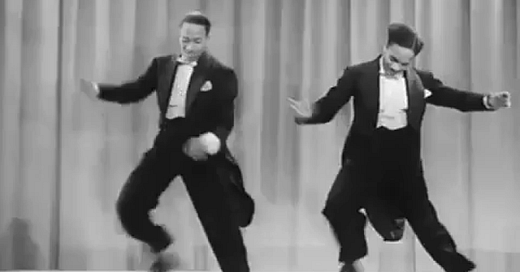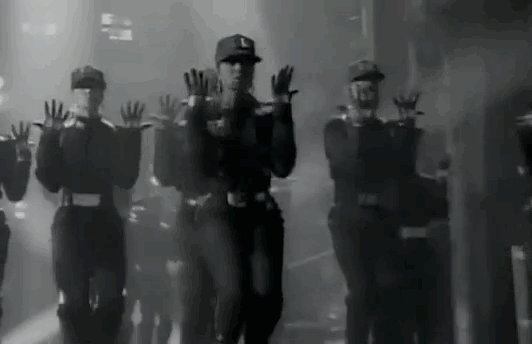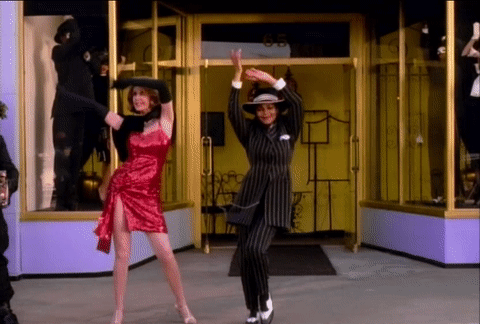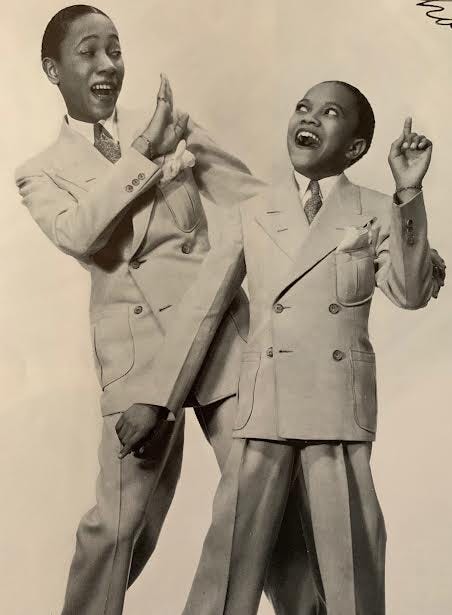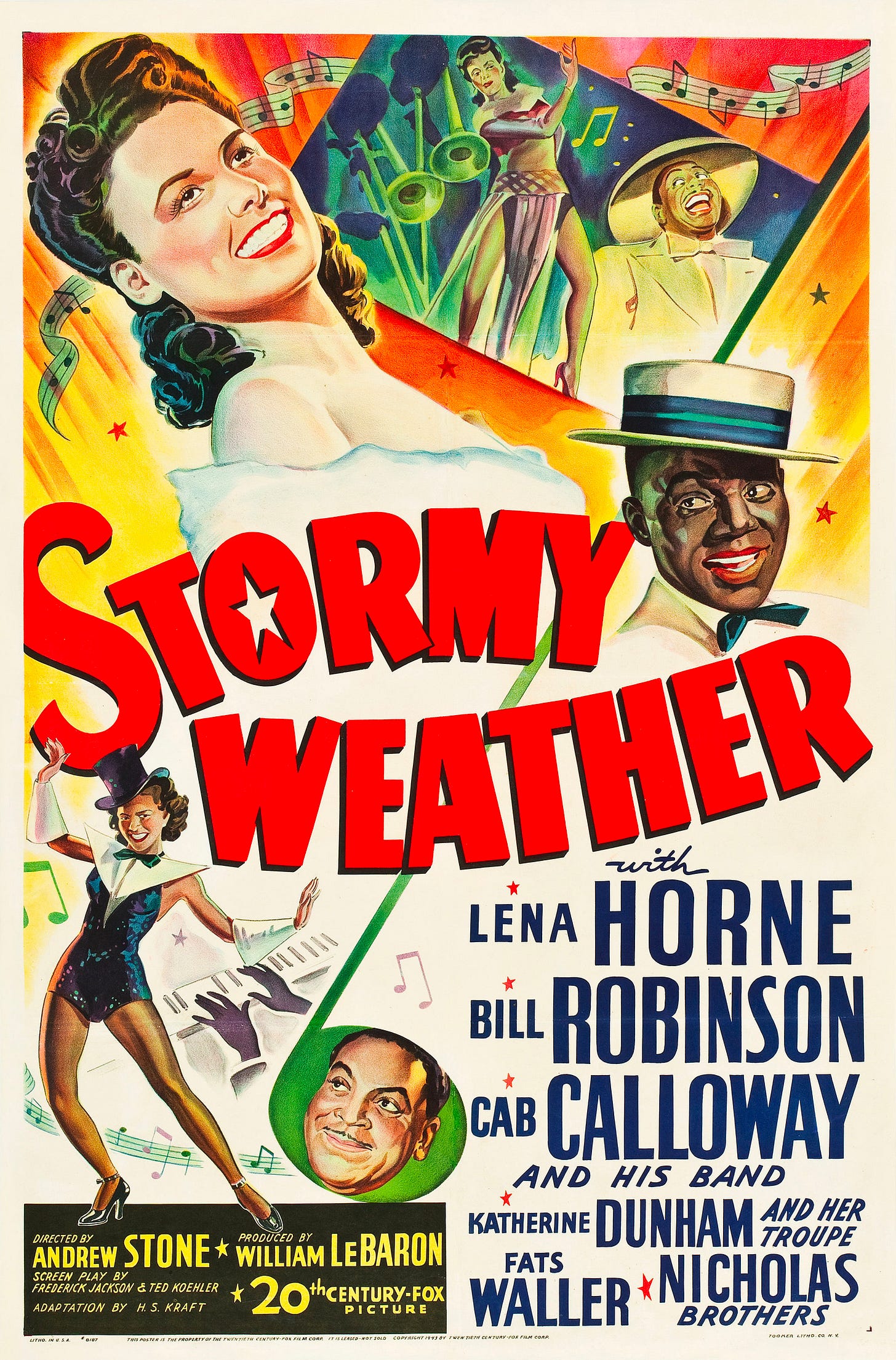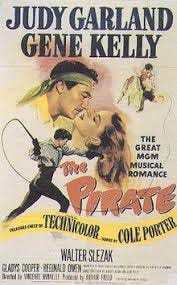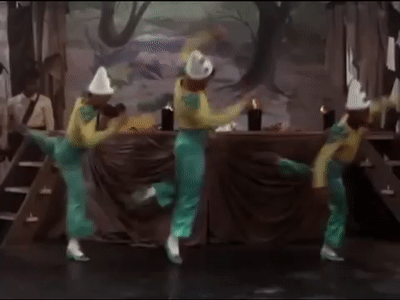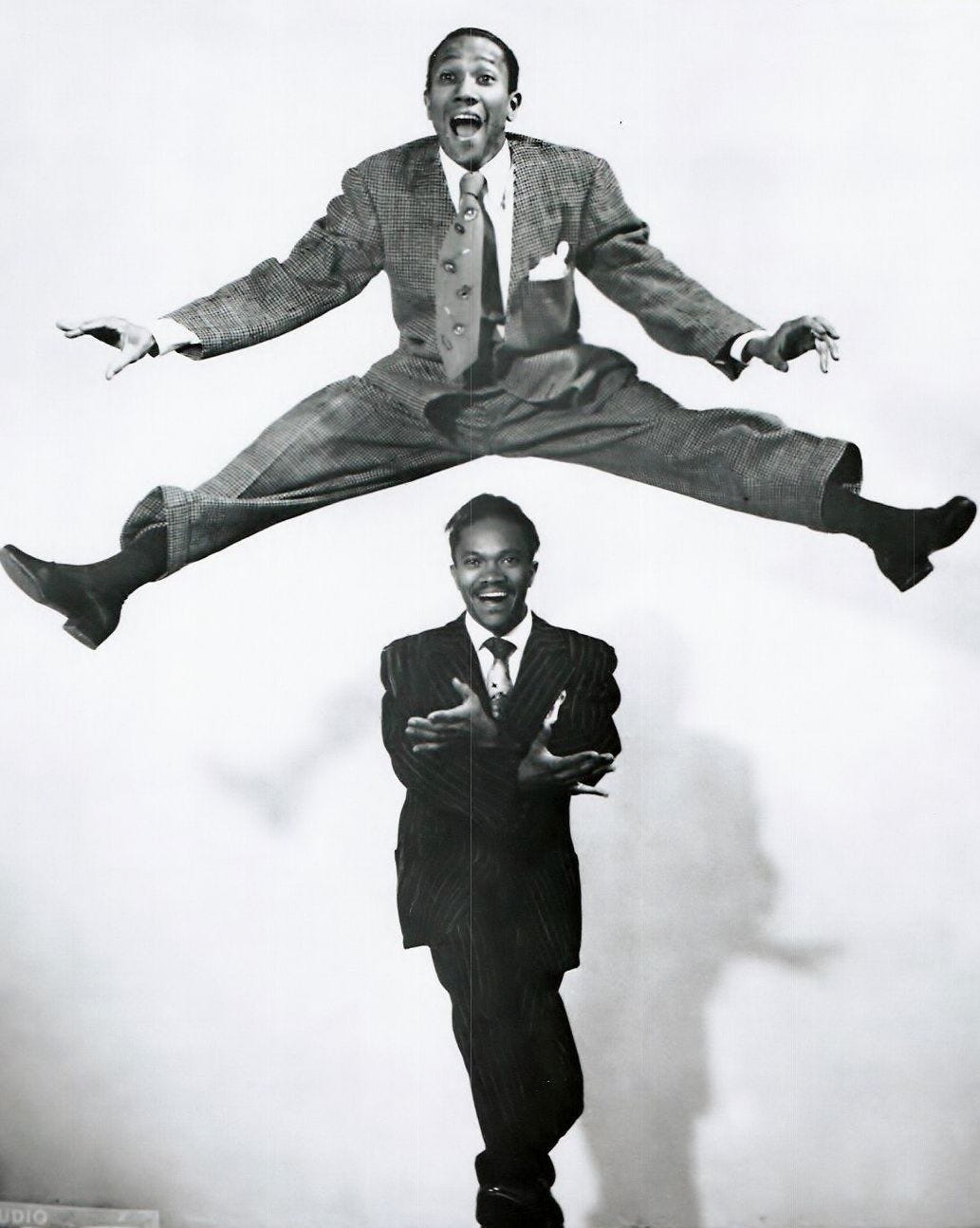Who Were The Nicholas Brothers?
And did they perform the best dance scene ever captured on film?
It turns out, you don’t need a DeLorean to go back in time…
In my case, you just need to go to see Janet Jackson in concert…
My love for Janet is well-documented, and last week as I sat in the audience of Janet’s concert, I was taken back to my childhood.
I could picture a very young Beth who wore out the Control and Rhythm Nation tapes, and who wanted to replicate the chair move from Pleasure Principle as well as the entire choreography of the Rhythm Nation video.
But after the concert, I got to thinking about another of Janet’s videos1 from my youth – Alright.
The video for Alright was styled to resemble the musicals from the 1930s and 40s, and filmed on the New York Street backlot at Universal Studios in Hollywood.
Alright opens with Janet learning that Cab Calloway is coming to town for a film premiere – and the video stars Calloway, as well as dancer Cyd Charise (who joins Janet for a short dance).
Even when the video came out in 1990, I was familiar with the names Cab Calloway and Cyd Charise, though I didn’t really know the details of their careers.
But the video also starred the Nicholas Brothers – whose names a young Beth did not know.
And like Cyd Charise, their moment in the Alright video is brief:
But after watching Janet in concert, I wanted to know more about these dancers — and when I read that famous dancer Fred Astaire said the Nicholas Brothers were behind the “greatest dancing ever seen on film”, I was curious…
Fayard Nicholas was born in 1914, and his brother Harold followed seven years later in 1921.
The brothers grew up around music, as their parents were musicians who performed in the orchestra in vaudeville shows. Their mother Viola was a pianist and their father Ulysses was a drummer.
Fayard learned to dance by watching other vaudeville performers.
“Make your whole body dance,” his father told him.
“Give it your own style.”
Fayard followed his father’s advice, and then passed on what he learned to his younger brother.
Though neither brother had any formal dance training, it wasn’t long before their tap and acrobatic skills got noticed – and they made their first appearance at New York’s famous Cotton Club when Fayard was 18 years old and Harold was 11.
According to the Nicholas Brothers website, they “astonished their white audiences just as much as the residents of Harlem slipping into their series of spins, twists, flips, and tap dancing to the jazz tempos of Bugle Call Rag.”
Their synchronized tap routines then took them to Broadway – and then to Hollywood.
The Nicholas Brothers’ mesmerizing dance routines saw them cast in dozens of movies in the 1930s and 1940s, where they worked with big stars like Fannie Brice, Bob Hope, and Josephine Baker.
But it is 1943’s film Stormy Weather that showcases their most famous dance sequence.
Their moment in the film comes when band leader Cab Calloway2 kicks off the song Jumpin’ Jive.
The Nicholas Brothers jump on their feet, and for three minutes showcase impressive athleticism, synchronized steps, and infectious energy.
[Please take a look — you won’t regret it!]
It is this scene that dancing legend Fred Astaire reportedly claimed was the greatest dancing he had ever seen on film.
Interestingly, many articles claim that the Nicholas Brothers performed this scene without rehearsal.
But is that true?
Well, according to a 1997 Chicago Tribune interview with Fayard, yes.
“Would you believe that was one of the easiest things we ever did?” Harold told the Tribune.
“When it came time to do that part, (choreographer) Nick Castle said: ‘Just do it. Don’t rehearse it, just do it.’
“And so we did it — in one little take. And then he said: ‘That’s it—we can’t do it any better than that.’”
“I sure was happy he said that—I didn't want to be doing that all night, over and over and over.”
But did they really perform Jumpin’ Jive in one take?
Though many articles repeat Fayard’s claim, the scene in the film suggests otherwise.
Historians note the scene does include cuts, and changes in camera angle that suggest more than one take was used in the final edit.
But the climactic scene at end where the brothers descend the stairs, leap over one another and perform the splits over and over again, IS a single shot.
Their scene in Stormy Weather closes the film, though in other films, the Nicholas Brothers appeared as speciality acts or guest stars, which allowed their scenes to be easily removed when the films were played in movie theatres in the American South.
Racism and prejudice meant the Nicholas Brothers were not given the opportunity to star in films like Astaire or Gene Kelly, but they certainly impressed their audience — and other dancers.
Kelly would go on to cast them in his film The Pirate in 1948.
And the Nicholas Brothers were so talented, they made their complicated routines and fancy footwork look easy.
Fayard recounted a story from rehearsals for The Pirate when Kelly —a perfectionist — wasn’t convinced Harold had the moves down.
“Gene and I were really going at it,” Fayard said in 2002. “Harold was taking it easy.”
“He was saying, ‘I got it, I got it,’ but Gene said, ‘Fayard, he says he has it, but I don’t think he has.’
“So my brother went through the whole routine without one mistake. Gene was so mad!”
The Nicholas Brothers continued performing for decades — and in 1990 even recreated a scene where they danced along with their younger selves from a routine they performed in 1935.
Note: Fayard is 76 in this clip!
The Nicholas Brothers performed for audiences around the world, and even for British royalty and nine US presidents.
They received many awards and honors for their contributions to dance and film. They were celebrated in the Kennedy Center Honors in 1991, received their star on Hollywood’s Walk of Fame in 1994, and were inducted into the National Museum of Dance Hall of Fame in 2001.
Harold Nicholas passed away in 2000 at age 79, while his older brother Fayard passed away in 2006 at age 91.
One more thing…
Here are a few more clips of the Nicholas Brothers in action:
Down Argentine Way - from the film Down Argentine Way (1940)
I've Got a Gal in Kalamazoo- from the film Orchestra Wives (1942)
And here’s Jumpin Jive (restored in color) from Stormy Weather (1943)
How Can I Help?
I’ll keep saying it: Communication matters.
If you want to improve your communication (and get all the good things that come with that), I’m your gal.
So many companies could reap massive rewards – from performance and culture to retention and engagement – by improving their communication.
So, if you know someone who could benefit from some help (as even the most seasoned leaders do), please get in touch and check out my website for more information.
You can also see my Top 10 list of what I can (and can’t) do for you here.
And if you see any communication examples (the good, the bad, and the ugly) that you think are worth analyzing or sharing, please send them my way!
Stay Curious!
-Beth
This was back in the day when MTV was a big deal, and when they played music videos.
Future Alright co-star, as well as famous jazz singer and bandleader

